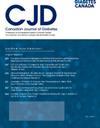Use of Sodium-Glucose Cotransporter-2 Inhibitors in Adults Aged ≥65 Years With Type 2 Diabetes and Cardiovascular Disease: A Cross-sectional Study of Different Drug Funding Policies
IF 2.3
4区 医学
Q3 ENDOCRINOLOGY & METABOLISM
引用次数: 0
Abstract
Objectives
Sodium-glucose cotransporter-2 inhibitors (SGLT2is) provide heart and kidney benefits in adults with diabetes and cardiovascular disease (CVD). Public drug coverage policies for SGLT2is differ by province in Canada. In this study, we describe the potential effects of prior authorization/step therapy (PA/ST) and relatively high income-based deductibles, compared with regular benefit status with modest copay, on SGLT2i prescriptions in high-risk adults.
Methods
This investigation was a cross-sectional study of adults ≥65 years of age with type 2 diabetes and CVD and taking at least 1 antihyperglycemic agent from 2019 to 2020. Using electronic medical record data obtained from primary care practices, we compared SGLT2i use (2019 to 2020) in Alberta (PA/ST, modest copay) and Manitoba (PA/ST, relatively high income-based deductible) vs Ontario (regular benefit status, modest copay). Poisson regression was used to adjust for confounders, including age, sex, glycated hemoglobin, and other medication use. Other diabetes medications were estimated as control cases.
Results
We included 3,191 adults (average age 75 years, 31% women). SGLT2i use was lowest in Manitoba (15.6%), followed by Alberta (25.9%), and highest in Ontario (31.9%). After adjustment, compared with Ontario, SGLT2i prescriptions were lower in Alberta (prevalence ratio [PR] 0.80, 95% confidence interval [CI] 0.71 to 0.91, p<0.001) and Manitoba (PR 0.48, 95% CI 0.39 to 0.59, p<0.001).
Conclusions
PA/ST and relatively high deductibles are associated with reduced SGLT2i prescribing---PA/ST by approximately 20% in Alberta and Manitoba, and relatively high deductibles by an additional relative reduction of 40% in Manitoba. PA/ST and cost-sharing policies should be flexible and responsive to changing evidence of clinical benefit.
阿尔伯塔省和曼尼托巴省 2 型糖尿病和心血管疾病患者(年龄≥ 65 岁)使用 SGLT-2 抑制剂的比例低于安大略省(2018-2020 年):不同药物资助政策的横断面研究》。
目标:钠-葡萄糖共转运体 2 抑制剂(SGLT2i)对成人糖尿病和心血管疾病(CVD)患者的心脏和肾脏有益。加拿大各省对 SGLT2i 的公共药物覆盖政策各不相同。我们的研究旨在描述预先授权/阶梯疗法(PA/ST)和相对较高的基于收入的免赔额与适度自付的常规福利状况相比,对高风险成人 SGLT2i 处方的潜在影响:横断面研究:使用来自初级保健实践的电子病历数据,对 2019 年至 2020 年期间年龄≥ 65 岁、患有 2 型糖尿病和心血管疾病、服用≥ 1 种降糖药的患者进行研究。我们比较了阿尔伯塔省(PA/ST,适度自费)和马尼托巴省(PA/ST,基于收入的免赔额相对较高)与安大略省(常规福利状态,适度自费)的 SGLT2i 使用情况(2019-2020 年)。采用泊松回归调整混杂因素,包括年龄、性别、糖化血红蛋白和其他药物使用情况。其他糖尿病药物作为对照病例进行估算:我们纳入了 3191 名成年人(平均年龄 75 岁,31% 为女性)。SGLT2i使用率最低的是马尼托巴省(15.6%),其次是阿尔伯塔省(25.9%),最高的是安大略省(31.9%)。经调整后,与安大略省相比,阿尔伯塔省(患病率比 [PR] 0.80,95% CI [0.71-0.91],p < 0.001)和曼尼托巴省(患病率比 0.48 [0.39-0.59],p < 0.001)的 SGLT2i 处方量较低:在艾伯塔省和马尼托巴省,PA/ST 和相对较高的免赔额与 SGLT2i 处方的减少有关,PA/ST 减少了约 20%,而在马尼托巴省,相对较高的免赔额又相对减少了 40%。PA/ST和费用分担政策应灵活应对不断变化的临床获益证据。
本文章由计算机程序翻译,如有差异,请以英文原文为准。
求助全文
约1分钟内获得全文
求助全文
来源期刊

Canadian Journal of Diabetes
ENDOCRINOLOGY & METABOLISM-
CiteScore
4.80
自引率
4.00%
发文量
130
审稿时长
54 days
期刊介绍:
The Canadian Journal of Diabetes is Canada''s only diabetes-oriented, peer-reviewed, interdisciplinary journal for diabetes health-care professionals.
Published bimonthly, the Canadian Journal of Diabetes contains original articles; reviews; case reports; shorter articles such as Perspectives in Practice, Practical Diabetes and Innovations in Diabetes Care; Diabetes Dilemmas and Letters to the Editor.
 求助内容:
求助内容: 应助结果提醒方式:
应助结果提醒方式:


